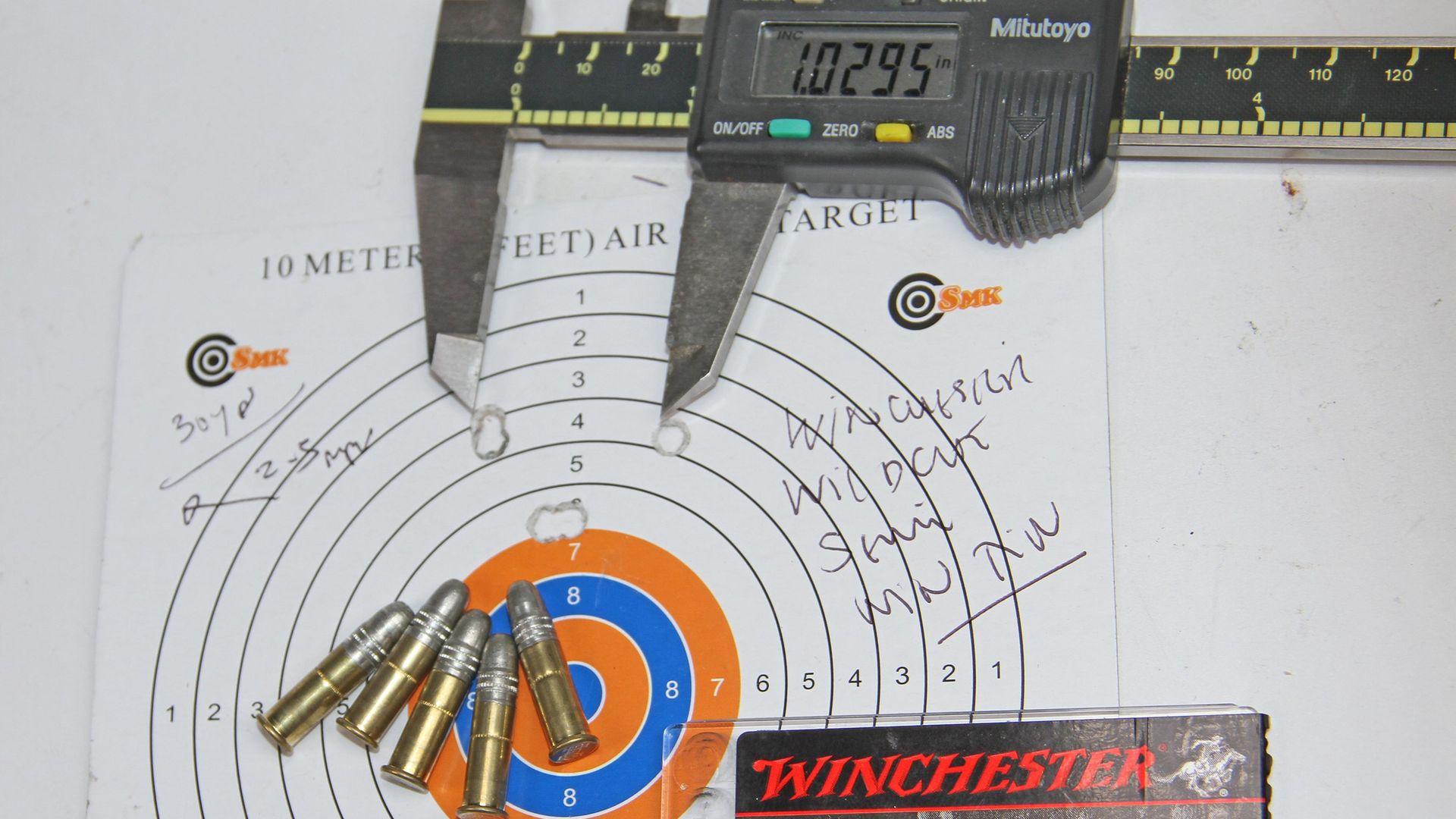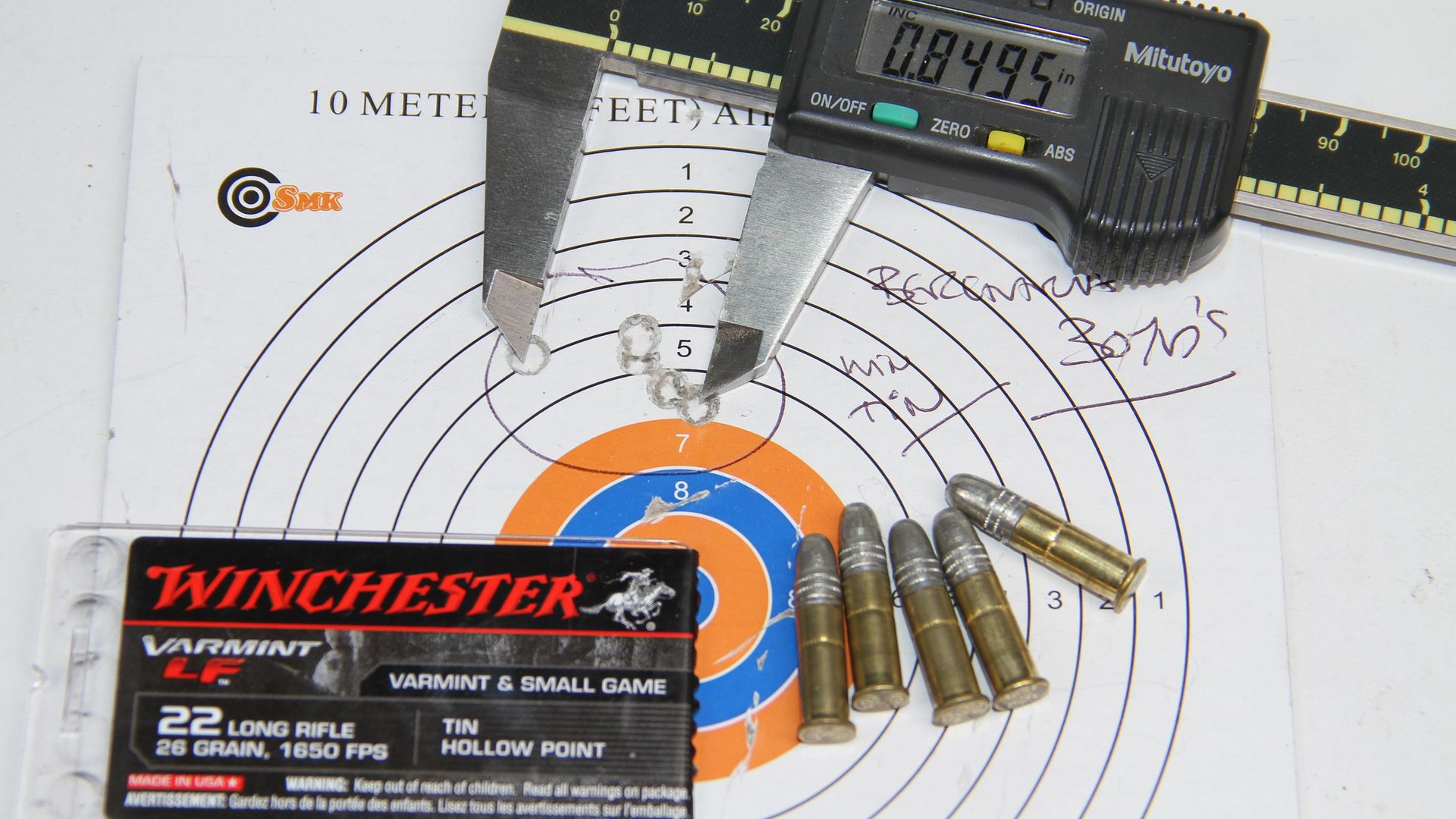Broadsword tests the latest lead-free .22 ammunition – Winchester Varmint LF .22 Tin - and his concerns about the future of the .22 continue undiminished...
With all this lead-free centrefire ammunition now being developed and the range of bullet types, calibres and weights being expanded, I find it extraordinary that bar a few .22 rimfire lead-free types, this category has really been largely left out.
The trouble is that making a conventional .22 calibre bullet lead free involves using some form of tin or zinc mixture. This, however, is not ideal as it means that for a bullet of the same dimensions – that is, with the necessary length to stabilise in a traditional 1 in 16" rifling – a lead-free .22 bullet is nearly half the weight of the original lead version. That’s why most of the available .22 LR lead-free ammunition has bullet weights between 24 and 26 grains.
This has produced another problem in that the velocity for such a light projectile has increased past 1,500 fps, making it hyper velocity. Some may say that’s great – I am sure our American cousins do! But it has a detrimental effect on ballistics, consistent velocities, accuracy and downrange energy retention. But for me, the main disadvantage is that you can no longer have a quiet subsonic .22 LR, which is the backbone of the sporting or vermin market. Even with a sound moderator on your rifle this new lead-free hyper-velocity ammo is going to be noisy. Eco-friendly my a…
The bullets may look the same as a regular lead projectile but you also have problems with lubrication down the bore, which greatly affects fouling, especially build up in the rifling grooves and leads of the chamber area.
You also have that age-old problem of ‘conditioning’ the bore when switching ammunition types. Have you noticed how changing from one brand to another takes 10 -20 shots to bed in the rifle before accuracy becomes consistent? It’s much like when you clean a rimfire’s bore; you always have to shoot it back in again to condition the bore to your ammunition to achieve best accuracy. You can see it clearly over the chronograph, with the first string of velocities varying, then steadily increasing and then flattening off with consistent velocities.
 credit: Archant
credit: Archant
Specifications
With that in mind let’s take a look at the Winchester Varmint LF. This is a .22 Long Rifle cartridge designed to mimic the profile of a standard lead .22 cartridge but using a tin hollow-point bullet. This bullet is 26gr and achieves a factory velocity figure of 1,650 fps velocity and 157 ft-lb energy.
Here we go again with light .22s and hyper velocity! The bullet is very obviously tin from its bright silver colouring and although light is hard to mark with your nails. The actual weight for an average of 10 bullets pulled and weighed was 26.0gr, so that’s a good start. The diameter is 0.223" across the driving bands and the overall length is 0.4665". A typical standard .22 LR lead bullet – in this case Eley subsonic – weighs 38.0gr with a diameter of 0.224" and a length of 0.4600".
So already we’re slightly longer for the 12.0gr lighter Winchester tin round. You have the same typical cupped rear section to the bullet, which is designed to expand and trap the expanding gases to assist in propulsion and engaging the rifling. Then there is the bearing surface of 0.223" diameter and 0.1535" length to engage and centralise the bullet in the rifling as in travels down the barrel. The bullet finishes with a low tapering conical nose section and lightly curved hollow point meplat that is well formed and clear of lube or swarf.
Most noticeable is the lack of wax or oil lubricant on these tin bullets. They do feel a tad tacky but are very dry compared with conventional lead bullets. This might affect consistency of results. We’ll see.
The overall length of the cartridge is 0.9845" and when the bullet was pulled we had an average 3.0gr of powder. This is 2.0gr more than in a standard .22 subsonic round. It’s very obviously not designed as a subsonic round, as the quoted velocity is 1,650 fps.
I measured the velocity from a Bergara bolt action and a Winchester Wildcat semi-automatic to ascertain performance in the field.
First up was the Bergara B14R custom with its 18" barrel, which achieved an unbelievable average of 1,775 fps velocity and 182 ft-lb energy over 10 rounds. That’s pretty impressive performance, but with a quite wide velocity range of 1,738 fps to 1,804 fps.
Switching to the Winchester Wildcat semi there was a dramatic drop in velocity. Now we had an average of 1,539 fps for 136.8 ft-lb energy. The serious 236 fps drop in velocity is due to the inertia bolt operation in the Wildcat’s mechanism.
With these results varying so much I also tried the ammo in a Ruger 10/22 and achieved a velocity of 1,597 fps/147.3 ft-lb and my Sako Finnfire with a 14.5" barrel for 1,678 fps/162.6 ft-lb.
This is all good information, but accuracy to me trumps everything else and “only accurate rifles are interesting”, to quote an old gun scribe. There are two aspects here to consider – one is best accuracy and the second is consistency. Both are interlinked as lead-free bullets perform differently from lead ones. As expected, when transferring from a well lubricated Eley subsonic lead .22 rimfire to these Winchesters it was necessary to run the barrel in with several rounds of the new ammo.
I shot a string of three five-shot groups at 30 yards and the first target was quite frankly hideous. With the second group it got better with fewer fliers, and then with the third group we were consistent. At 30 yards these tin bullets grouped at between 0.85" to 1.00", which is reasonable but hardly fantastic to be honest. We also had the odd flier, as minimal lube meant the barrel was running dry and affecting the friction between bullet and rifling, which altered the accuracy.
The Winchester Wildcat semi-automatic fared OK, but again at least 20 rounds were needed to transition between lead and non-lead bullets. The average accuracy at 30 yards was 1.25". Again that’s acceptable, but often ruined by a flier from the group.
This was not the best accuracy in the world and as a result 30 yards would be my limit, to be honest. Even with a sound moderator fitted the muzzle report was loud and snappy. Using the Bergara B14R we measured velocity at 50 yards, achieving 1,285 fps. That gave a calculated ballistic coefficient of 0.059 compared with the factory quoted 0.062 G1.
Compared with the Eley subs control bullet there is a big difference in downrange performance, as expected from such a fast tin bullet. The trajectory chart (right) gives detailed performance information.
The Eley showed classic expansion and depth of 0.3925" and 8.0" respectively compared with the Win tin, which only expanded to 0.2610”. In other words, that was just the tip section, which broke off a bit as the retained weight was 23.4gr not the initial 26.0gr. It penetrated almost the same as the Eley at 7.5" but that made a huge difference in the wound channel volume – 420ml compared with 215ml for the Eley subs, but there is nearly twice the energy associated with the tin projectile. The Win tin, however, did track very well with little diversion from its penetration axis.
I did take the Bergara out rabbiting and had some nice head shots, but at no more than 40 yards max. You can see how fast it loses velocity and energy, and the wind drift figures are nothing to shout about.
 credit: Archant
credit: Archant
 credit: Archant
credit: Archant
Conclusions
The British shooting public are crying out for a decent non-lead subsonic round for vermin control – if we are forced to go the non-lead rimfire route. This Winchester Varmint LF, although possessing impressive velocities, does suffer (as all non-lead projectiles do), with a few accuracy and consistency problems. It produces a very good wound channel but you need to hit the target accurately first.
Some sort of lead-equivalent-weight projectile needs to be produced to achieve good subsonic performance. This Winchester Varmint LF bullet would need to be half as long again to make the standard 22 LR bullet weight and therefore made to go subsonic, but as we all know that would mean the 1 in 16 twist common to most rimfires just wouldn’t stabilise it.
The quest continues...
 credit: Archant
credit: Archant
Winchester Varmint LF trajectory
| 0yds | 30yds | 50yds | 75yds | 100yds |
Velocity
(fps) | 1775 | 1459 | 1285 | 1119 | 1012 |
Energy
(ft/lbs) | 182 | 123 | 95 | 72 | 59 |
Drop
30 yd zero
(") | 0 | 0 | +0.5 | -0.2 | -2.3 |
Drop
50 yd zero
(") | 0 | -0.3 | 0 | -0.8 | -3.4 |
Wind drift
@10mph
(") | 0 | 0.9 | 2.7 | 6.3 | 11.3 |
Winchester Varmint LF penetration
Make | Winchester
Varmint
LF (26gr) | Control sample
Eley subs
(38gr) |
Muzzle
velocity
(fps) | 1775 | 1055 |
Muzzle
energy
(ft-lb) | 182 | 94 |
Retained
weight
(grains) | 23.4 | 22.0 |
Penetration
(") | 7.5 | 8.0 |
Maximum
diameter
(") | 0.2610 | 0.3925 |
Wound
channel
(ml) | 420 | 215 |
Contacts
ISB Brands, Winchester ammo, Wildcat rifle
Tel: 01235 514550
RUAG, Bergara 22 rimfire
Tel: 01579 362319
Norman Clark, Chronograph, ammo
Tel: 01788 579651